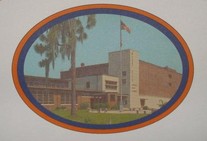
Plant City High School

History of Marshall High School
Compiled by Eddie C. Brooks, Sarah Governor, James R. McDaniel, Helen Rivers, and James Washington
(E. J.) Marshall, the first African American to serve as a school trustee in the Plant City area, was instrumental in persuading the City of Plant City to deed property to the School Board for the purpose of building a new facility to educate the black children in the community. Mr. Marshall, who was born in Aiken, South Carolina in 1864, came to the Tampa area in the early 1900's and later settled in Plant City. In 1920, Mr. Marshall’s dream was realized with the construction of Midway Academy, a magnificent two-storied, red brick structure, on property bound by Renfro Street (Georgia Street) on the north, Gordon Street on the east, Warren Street (Florida Street) on the south, and Warnell Street on the west. The school initially served grades 1-8. Beginning in 1936, one additional grade level was added each year so that ultimately grades one to twelve were taught. The School Board referred to the upper grade levels as Plant City Negro Junior High and Plant City Negro High School even though all were housed on the same campus as the elementary school which was still called Midway Academy. Certificates reflecting Plant City Negro Junior High School were given to students who completed the prescribed junior high school studies for the seventh and eighth grades. Diplomas denoting Plant City Negro High School were provided to those who completed studies through the twelfth grade. The names were not popular in the black community and most referred to the entire school as Midway Academy. In 1949, the name of the school was changed to Marshall High School to honor E. J. Marshall, a pioneer and champion for the needs of the black children in the Plant City community. As the population of Plant City began to increase, the original structure was inadequate to serve all of the children in the community. Portable buildings were added but soon became overcrowded. In 1953, Marshall’s school calendar was changed from the Strawberry School Session to the standard school year as the rest of the students in Hillsborough County. For several students this was the year of the double promotion. During this year, the Strawberry School only ran from March to June. When the students came back to school in September, they were required to take a test to see if they were capable of passing to the next grade level. The students called this experience “The Big Wreck” as they felt that a lot of damage was done when they had to leave many of their friends behind. In 1957, to help ease the congested conditions, a new edifice to house grades 7- 12 was built on Maryland Avenue. The name, “Marshall High School,” was transferred to the new school. The original Midway Academy building was renamed Lincoln Elementary and commissioned to provide instruction to students in grades 1-6. Fifth and sixth grade students who resided in the Lincoln Park area but had been sent across town to attend Simmons Elementary School when it was built in 1951 were also transferred back to Lincoln Elementary. Several dynamic principals emerged from the community and surrounding areas to ensure that a quality education was provided to the students, even though textbooks, instructional materials, and student supplies were often inadequate. Professor Cary Jones of St. Petersburg, Florida, was the first principal of Midway Academy. His wife, affectionately referred to as “Aunt Jenny,” was one of the first teachers. Other principals of Midway Academy include Mr. Godbolt, C. B. Bryant, Fred W. Johnson, Fred D. Smith, and Chester C. Seabury. The principals of Marshall High School were Fred D. Smith (1949-54), E. L. Bing (1954-67) and Sam Horton (1967-69). Under these vibrant and charismatic leaders, the students of Marshall High School, Midway Academy, and Plant City Negro High School excelled academically and athletically. Championships and outstanding performances were achieved in football, baseball, basketball, and golf. Under Coach Otis Williams, the Dragons won the Florida Interscholastic Athletic Association (FIAA) state baseball title in 1963, beating the defending state champions, Sanford Crooms High School, 9-4. In 1964, Coach Kelly Williams’ football team didn’t allow a point, finished 9-0 and won the Southwest Conference Championship. The 1957 football team, which was also coached by Kelly Williams, had a 9-1 record and were co-champions with Palmetto High School. Graduates have become doctors, lawyers, educators, business owners, professional athletes, and have worked in a myriad of professions. Unfortunately, with the integration of Hillsborough County public schools, the legacy of Marshall High School ended with the class of 1969. Marshall became a seventh-grade center and later, in 1995, a middle school for grades 6-8. Principals who have served at Marshall Seventh Grade Center and Middle School include: Sam Horton (1969-71); Earl Sykes (1971- 85); Janelle Wade (1985-86); George Montz (1986-92); Sarah Governor (1992-2003); Josephine Saunders (2003-2006); Shaylia Hall (2006- 2008) and Fay Durant (2008-2010) and Daphne Blanton (2010-present). Earl L. Sykes (Class of ‘56) and Sarah Governor (Class of ‘62) were graduates of Marshall High School. Even though the name is not posted on any building, the roar, pride and spirit of the Marshall High Dragons is still alive today.




